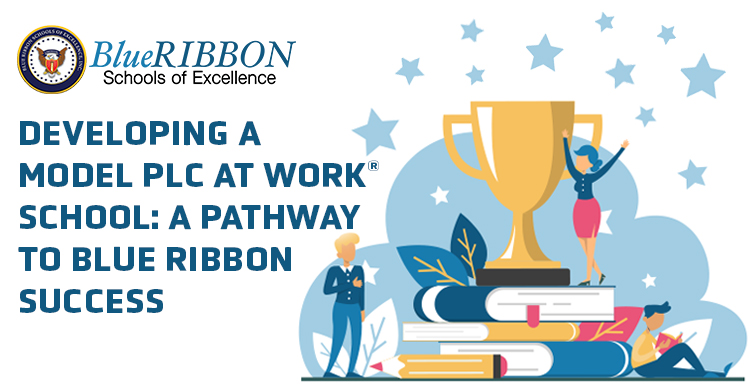If you’ve been in education for any period of time, you’ve probably come across the term “professional learning community” or “PLC.” According to AlllThingsPLC, PLCs are learning communities that are committed to an ongoing process in which educators work collaboratively and continuously to achieve better results for the students they serve through collective inquiry, investigation, research, and action.
Meanwhile, the National Blue Ribbon Schools (NBRS) Program, first introduced by the US Department of Education (DOE) in 1982, recognizes public and private elementary, middle, and high school excellence and/or progress in closing academic achievement gaps. Since the first NBRS awards were distributed in 1983, over 9,000 schools across the nation have been honored for their hard work in overcoming challenges and working as single units to change the future of education.
Whether all this sounds familiar or foreign, there’s a proven pathway to Blue Ribbon success through PLC tenets, concepts, and evidence-based processes. Here, we’ll cover the criteria to become a Model PLC at Work® campus as well as what needs to be on a school’s checklist for the DOE to recognize them as a National Blue Ribbon School.
Reaching Model PLC at Work® Status: It Takes Time, But It’s Worth It
Professional learning communities are a powerful way to improve student learning. In this approach, teachers and staff are all about helping every student learn and grow. Their environment often reflects this as they strive to create a highly collaborative culture using shared data to identify areas for improvement and strategies for student success.
But this process is not an overnight equation, and PLCs require continuous effort as educators strive to achieve better results for their students.
At the heart of the PLC at Work process are four critical questions that drive the daily actions of every team member:
What do we want our students to know and be able to do?
How will we know if each student has learned it?
How will we respond when some students do not learn it?
How will we extend the learning for students who have demonstrated proficiency?
Schools that demonstrate a commitment to the PLC at Work concepts, implement them over at least three years, present evidence of improved student learning, and provide yearly data that shows they’re continuing to meet the criteria of the PLC at Work process can apply and become a Model PLC at Work campus.
Here are a few tips that schools across the country have used on their PLC journeys:
- Establish a guiding coalition of key teacher leaders.
- Define collaboration and protocols of highly effective teams.
- Principals, teachers, and support staff need to collaborate in fostering a culture where everyone shares the responsibility for the learning of all students.
- Examine student performance data.
- Collect data on student learning and use it to inform instruction.
- Create professional development opportunities for staff to learn the PLC process.
It bears repeating that reaching Model PLC at Work status requires patience. With teacher shortages and retention concerns, state standards, learning loss, and other critical education challenges, taking the necessary time to develop a culture of collaboration and continuous improvement is understandably difficult. But it is an investment that is well worth it. When schools create a culture of collaboration and continuous improvement, all students benefit.
The Essential Ingredient to Earn the National Blue Ribbon School Award
There is a strong connection between the PLC process and the National Blue Ribbon Schools Program. After spending years of effort and collaboration developing a PLC, many schools will often follow up and apply for the National Blue Ribbon School Award from the Department of Education.
Each year, the DOE selects elementary, middle, and high schools, both public and private, based on their academic performance and their progress in closing the achievement gap. These Blue Ribbon schools are often known for their strong focus on professional development, collaborative culture, and commitment to equity and inclusion.
The NBRS award is a coveted recognition for schools nationwide, but the application does not guarantee a win; a rigorous review process happens for each applicant school to ensure a level of excellence that represents the hard work of students, educators, and families in creating safe and welcoming schools where students thrive.
Here are some facts about the Blue Ribbon process:
- K–12 public schools are nominated by their chief state school officer.
- At least one-third of the public schools nominated by each state must be schools with a high percentage of students from disadvantaged backgrounds.
- A public school must meet several criteria based on the performance of its students on state assessments in reading (or English language arts) and mathematics.
When schools implement the PLC at Work process effectively, they are more likely to meet the rigorous criteria for the NBRS Program. If your school is interested in earning national recognition from the Department of Education, developing a strong PLC and becoming a Model PLC at Work school is the logical first step.






